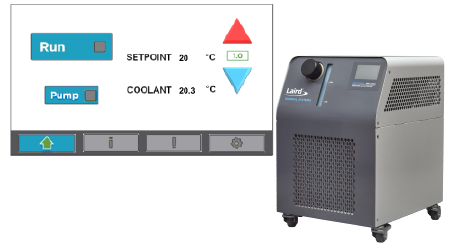 Liquid Cooling Systems can be equipped with either custom-made or off the-shelf controllers to improve temperature stability and usability.
Liquid Cooling Systems can be equipped with either custom-made or off the-shelf controllers to improve temperature stability and usability.
Our Nextreme™ Recirculating Chiller Platform features an advanced software integration that enables very high temperature stability of up to ±0.05°C for thermoelectric-based and ±0.1°C for compressor-based systems. The Nextreme interface features an intuitive, color touchscreen display that allows users to directly control and manage system settings.
Nextreme Chiller Temperature Control Features
The Nextreme temperature controller offers a wide range of features that can be customized to meet unique application requirements.
- Regulator Modes
LTS controllers can operate in either ON/OFF or PID (Proportional Integral Derivative) control.The ON/OFF mode works by setting up a hysteresis range. Once the temperature setpoint is achieved, the temperature controller is shut off. If the temperature falls outside this range, cooling or heating will be turned on. Since frequent starting and stopping of electric motors, especially compressors, reduces operating life, this type of control is not generally used with applications requiring tight temperature control.
By operating in PID mode, the temperature controller uses proportional regulation to maintain a constant temperature with minimal fluctuations. The electric motors (compressor and fan) run continuously, while PID algorithms determine the output value to control the speed of the motors and position of valves, all maintaining temperature control of the system.
- Fan & Compressor Speed Control
Variable speed motors for the compressor and condensing fan in the Nextreme Chiller platform allow for higher efficiency and improved temperature stability. Lowering the speed of fans and compressor can also reduce noise, which is often desirable for instruments used in lab environments.
- Touchscreen Display
Users can easily control and monitor the system via the intuitive LCD display. Interaction with temperature control systems is often infrequent, so interaction needs to be efficient. The Nextreme interface allows for fast system setup and clear system monitoring that does not require the need of referencing error codes in a user manual. Multiple screen views are available to view status and adjust system operation including:
- Temperature setpoints
- Alarms
- Pump operation
- Coolant type
- Flow rate
- Sensing and Monitoring
Sensors are used to maintain a specific temperature setpoint and provide feedback to the control system. They can be used for both monitoring critical components and to directly control the cooling unit. A number of sensors are commonly used, such as thermistor, pressure, current and flow.
- Alarms
Users will be alerted if critical values (temperature, pressure, or flow) go beyond specified limits. The temperature setpoint and alarms can be easily adjusted from the LCD panel. Available alarm features:
- Low or high temperature alarm
- Low or high pressure alarm (coolant and refrigerant)
- Low fluid
- Flow alarm
- Max current alarm
- Low tachometer alarm
- Critical sensor check during operation
- Data Collection
Understanding the circumstances of operation prior to an unplanned event can be instrumental in understanding a system behavior or failure. Data parameters such as temperature, pressure, fan speed, current draw etc. can be saved to memory in the unit, capturing time critical measurements. This data can then be analyzed in order to prevent reoccurrence and improve system uptime.
Learn More
Find more details about the temperature controller features in the Nextreme Chiller User Manual.
For any questions about our software integration on liquid cooling systems, please contact our thermal experts at Laird Thermal Systems.
